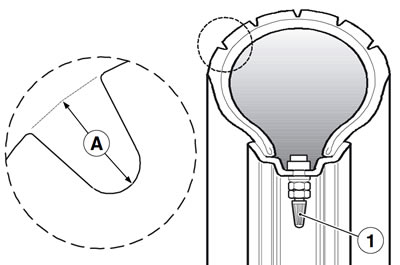It is a good rule to measure tyre inflation pressures before and after a long trip.
Tyre inflation pressures should be checked monthly with the tyres at ambient temperature.
This vehicle is fitted with tubeless tyres.
For inflation pressures, see 1.7.1.
Tread condition
Warning!
- Inspect tread surface and check for wear. Badly worn tyres adversely affect traction and handling.
- Always change a worn tyre. A tyre that becomes punctured in the tread area should be changed when the puncture is larger than 5 mm.
- Some of the tyre types approved for this vehicle are fitted with wear indicators.
- There are various types of wear indicators.
- Enquire about correct wear inspection procedure with your supplier.
- Never use tube tyres on tubeless tyre rims, or viceversa.
- Always check that the caps are in place on the valves (1), or the tyres may deflate suddenly.
- Tyre replacement and repair, and wheel servicing and balancing are delicate operations. They should be carried out using adequate tools and are best left to experienced mechanics.
- The wheel must be balanced after each tyre repair.
- New tyres may be coated with an oily film. Drive carefully until covering several kilometres. Never apply non-specific products to the tyres.
- Approved tyre sizes are reported in the registration document. Installing nonapproved tyres is a legal offence.
- Using tyres other than the specified sizes may change vehicle behaviour, impair handling and make the vehicle unsafe to ride.
- Use only the first-equipment tyre types selected by aprilia; see 1.7.1.
Minimum recommended tread depth (A): Front and rear tyre 2 mm (2 mm).

